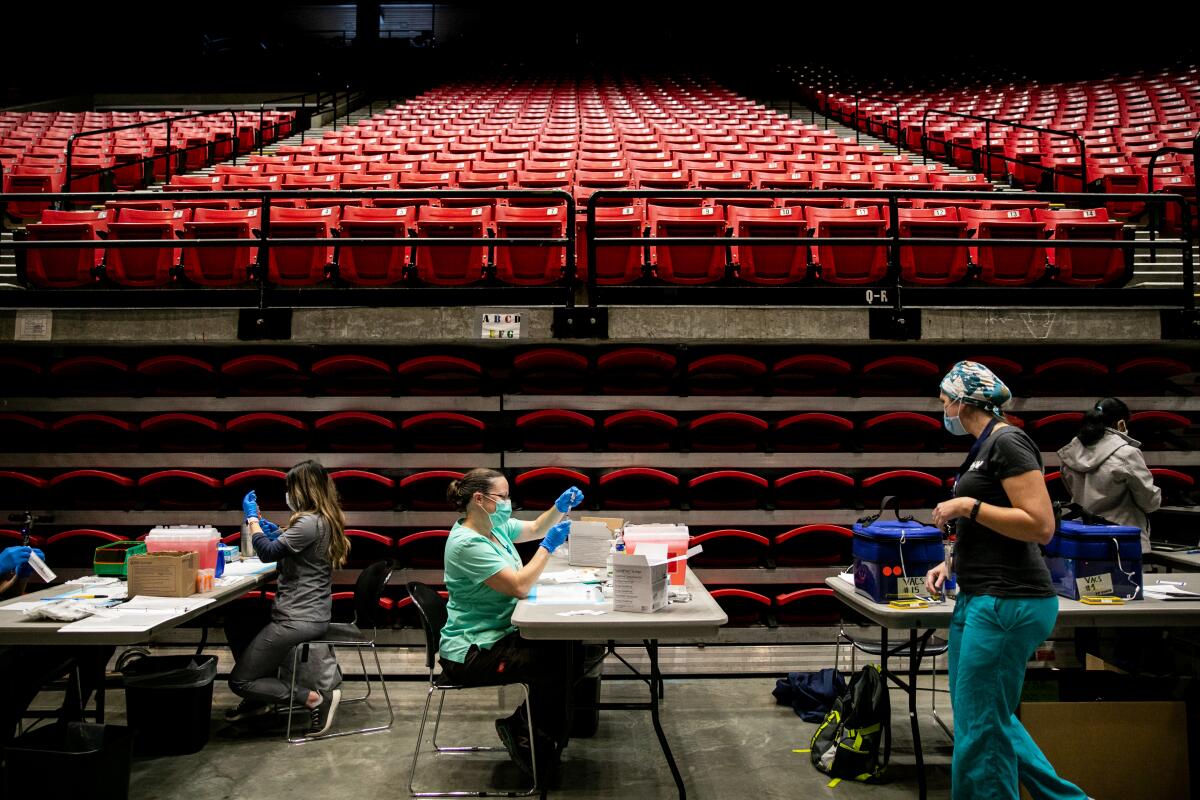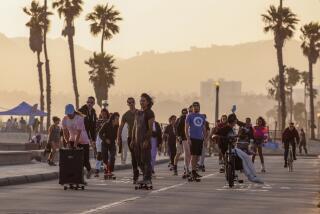Brazilian coronavirus variant detected in San Diego

San Diego joins 18 regions nationwide that have reported cases of Brazilian coronavirus variants which have the ability to reinfect people who have been infected by other viral varieties.
County officials announced that two cases of the COV2 lineage dubbed “P.1” have been confirmed in the San Diego region.
One case is a person who recently entered the country from Mexico and is not a local resident. The second person lives in the area.
Case investigators have found no connections between the two people, said Dr. Eric McDonald, medical director of the county’s epidemiology department.
“The resident of San Diego County had no travel history, so that means that there must be at least one other case in San Diego,” McDonald said.
First detected in and around Manaus, the largest city in north Brazil’s Amazonas state, the new variant became a second public health crisis for Brazil in early March, with record numbers of deaths recorded in places that had already experienced a harrowing outbreak in December.
As cases have rushed across the South American nation, the death toll has surpassed 300,000, with intensive care units’ occupancy rates in 15 of Brazil’s 24 federal units reaching or surpassing 90%, according to a recent government report.
Earlier government tweet had caused confusion
The U.S. Centers for Disease Control and Prevention has listed 61 reported P.1 cases nationwide Tuesday, with four in California.
The first was reported to the California Department of Public Health on March 13 from San Bernardino, with additional cases confirmed in Orange and El Dorado counties on March 18. One of San Diego’s two cases was included in the state’s most recent update.
Brazil is a contrast from California and San Diego’s situation. Here many people are most intensely interested in when the currently-low new virus case totals and hospital occupancy rates will translate into a more widespread reopening of restaurants, gyms and — on April 1 — the return of fans in stands for sporting events and of visitors to long-shuttered amusement parks.
McDonald said the public should continue to do what it can to prevent the spread of the virus — even at a time when the virus is showing much less activity — to avoid a resurgence just as vaccination efforts are beginning to show a never-before-seen level of control.
“It is possible that some vaccines may be less effective or that somebody who has already had COVID might be reinfected,” McDonald said of P.1. “It does not necessarily appear, at this time, that it’s something that is more transmissible to others, but that’s something that’s being researched.”
Neither of the two local P.1 cases became sick enough to require a hospital stay, McDonald said, and neither had been vaccinated. Nor had they previously been infected with a different COV2 type.
The local resident, said to be a woman in her 40s, was tested on March 5, although results of genetic sequencing, which is necessary to determine the variant involved, did not arrive until last weekend. The resident was in contact with six other people, all who tested negative and who are now finishing quarantine periods, McDonald said.
The traveler from Mexico was tested on March 9, and the county received the results of genetic testing on Monday. The person was tracked down at a local hotel after testing positive and isolated before exposing others, McDonald said.
He did not disclose the gender of the traveler.
The overall susceptibility of P.1 to the currently approved group of vaccines remains an open question, though there is some reason to believe that the shots going in arms recently may convey at least partial protection, experts say.
There are dozens of mutations found in the Brazilian variant, but the three most important sit in the so-called spike protein, which the virus uses to latch onto cells before slipping inside them. At least one mutation makes it harder for the virus to be recognized by antibodies — the Y-shaped immune proteins that glom onto a virus and can block infection if they grab tightly enough at the right spot.
But there’s good reason to think the current vaccines help against the variant.
For instance, Johnson & Johnson’s COVID-19 vaccine was 66% effective in Latin America, where the Brazilian strain is particularly prevalent. For perspective, the typical seasonal flu vaccine is 40% to 60% effective, according to the CDC.
The Moderna and Pfizer vaccines were tested before the rise of fast-spreading variants, which makes it harder to definitively say how well they work against the Brazilian variant.
But scientists have tested how well antibodies found in the blood of vaccinated people block the variant from infecting cells in the lab. Recent studies show that antibody responses to the Moderna and Pfizer vaccines are 3.5 and 2.6 times less effective in blocking the Brazilian variant, respectively.
Relating those numbers to outcomes in people is tricky, because a weaker antibody response could still protect against severe disease and death. And since these experiments focus on antibodies, they don’t factor in the contribution of other immune cells — such as T cells, which kill infected cells before they can spew out more virus.
That’s why Dr. Davey Smith, UC San Diego’s chief of infectious disease research, stresses that the best way to deal with the variant is still to vaccinate as many people as possible, as quickly as possible.
“What should we do about it? We should still mask and socially distance and everybody needs to get vaccinated, because every person who’s vaccinated means there’s less chance of spread of all the viruses,” Smith said.
“Even if that variant gets around some of the vaccination, that doesn’t mean that we should just throw up our hands and say, ‘Sorry, it doesn’t work.’ It does work; it’s just that maybe there’s a decrease.”
Overall, coronavirus activity remains flat in San Diego County, with 243 additional cases and four deaths, officials announced Wednesday. Local hospitals reported 227 local COVID-related hospitalizations Tuesday.
Sisson and Wosen write for the San Diego Union-Tribune.
More to Read
Sign up for Essential California
The most important California stories and recommendations in your inbox every morning.
You may occasionally receive promotional content from the Los Angeles Times.












